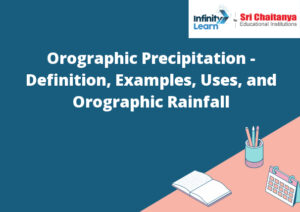Table of Contents
Orographic precipitation, often referred to as relief precipitation, is a meteorological phenomenon that occurs due to the interaction between air masses and mountain ranges. This process plays a significant role in shaping the distribution of rainfall in various regions around the world. In this article, let us delve into what is orographic precipitation, its causes, its uses, and other related info.
What is Orography?
Orography is the study of the physical features of mountains. This includes their shape, size, and the way that they are formed. Orography can also include the study of the climate and weather patterns that are found in mountainous areas.

What is Orographic Precipitation?
Orographic precipitation is a type of precipitation that is caused when masses of air are forced to rise over high terrain, such as mountains. The air rises, and as it does, it cools. The moisture in the air condenses and forms clouds and rain. Orographic precipitation is common in mountainous areas, such as the western United States.
Generating the Precipitation
Precipitation is generated when the water vapor in the atmosphere reaches a saturation point. The saturation point is the point at which the air cannot hold any more water vapor and the water vapor begins to condense. This can happen in a number of ways, but the most common is when the air temperature falls below the dew point. The dew point is the temperature at which the air can no longer hold the water vapor and the water vapor begins to condense.
What is Orographic Lift?
The lifting of air masses by the mountains is called orographic lift. The air is forced up the slopes of the mountains and cools as it rises. This cooling process causes the water vapor in the air to condense and form clouds. The clouds then release rain or snow, which can lead to severe weather conditions.
Cause of Orographic Rainfall
The main cause of orographic rainfall is the presence of mountains. When moist air rises over a mountain, it cools and releases moisture in the form of rain or snow. The higher the elevation of the mountain, the more moisture the air will release.
Examples of Orographic Precipitation
- snow
- sleet
- hail
- rain
What is Orographic Precipitation?
Orographic precipitation is created when moist air is forced up the side of a mountain, and the moisture in the air condenses and falls as rain or snow. The exact type of precipitation that falls depends on the temperature of the air and the amount of moisture in it.
Uses of Orographic Precipitation
Some of the primary uses of orographic precipitation include providing water to crops and other vegetation, filling reservoirs, and generating hydroelectricity. Orographic precipitation can also help to reduce the risk of wildfires.
Drawbacks of Orographic Precipitation
There are a few drawbacks to orographic precipitation. One is that it can lead to dangerous flash flooding, as the water is not able to soak into the ground very well. Additionally, it can also lead to very heavy rains and possible landslides.
Orographic Cloud
An orographic cloud is a cloud that forms when air is forced to rise over a mountain. The air cools as it rises, and the water vapor in the air condenses to form a cloud. Orographic clouds are often seen on the leeward side of mountains.
Rain Shadow
The rain shadow is the area of the world that is “shadowed” from the rain by a mountain range. The mountain range blocks the rain from reaching the area, so the rain shadow is usually much drier than the surrounding areas.
Effect of Precipitation on Air Pollution
The main effect of precipitation on air pollution is that it helps to clear the air. Precipitation helps to wash away pollutants and to dilute them so that they are less harmful. This can help to improve air quality, especially in areas where there is a lot of air pollution.
Meteorology Impact on Agriculture
The weather has a significant impact on agriculture. The most important aspect of the weather with respect to agriculture is the amount and timing of precipitation. Too much or too little precipitation can lead to decreased crop yields. The type of precipitation (rain, snow, sleet, hail) can also affect crops, with hail being the most damaging. Wind can also damage crops, as can extreme temperatures.
Notable Occurrence Locations
The Amazon rainforest, the world’s largest rainforest, is located in South America.
Also Read: Climate Class 9 Extra Questions Geography Chapter 4
Frequently Asked Questions (FAQs) on Orographic Precipitation
Orographic precipitation is rainfall caused by moist air being forced to rise over a mountain range, cooling and condensing to form clouds and precipitation.
Moist air encounters a mountain barrier, rises along the windward side, cools, and condenses to form clouds and rain.
The rain shadow effect occurs on the leeward side of the mountain, where descending dry air inhibits cloud formation and leads to drier conditions.
It causes heavy rainfall on the windward side, leading to lush vegetation, while the leeward side experiences drier conditions due to the rain shadow effect.
It contributes to water resources by filling rivers, lakes, and reservoirs, supporting ecosystems and providing water for various needs. What is orographic precipitation?
How does orographic precipitation occur?
What is the rain shadow effect?
How does orographic precipitation affect rainfall distribution?
Why is orographic precipitation significant?








